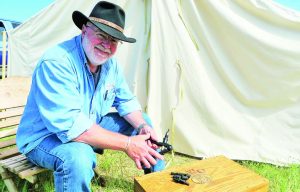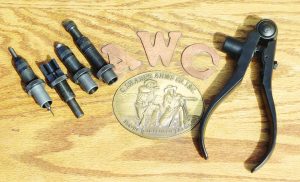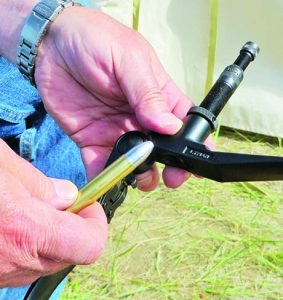by Mike Nesbitt | Contributing Editor

Allen Cunniff in front of our tent at Quigley shoot in Montana, getting ammo reloaded.
The need to reload cartridges right in camp certainly goes back to the buffalo hunters of the 1870s. They cast their own bullets, wrapped those bullets with paper patches, and loaded them, often at night to be prepared for the next day’s hunt. Doing that today should be no more difficult and we do have the advantage of the easy to get Lyman 310 too. This was the tool we selected to use while making blackpowder loads for our .45/70 Sharps rifles, doing that loading right in camp.
My partner on last year’s trip was Allen Cunniff and we were camped at the Matthew Quigley Buffalo Rifle Match near Forsyth, MT. That’s quite a camp and we stayed there a whole week. Enough shooting was done that having reloading gear with us was not a requirement but certainly a good idea. Bullets had been cast ahead of time although we could have cast those bullets in camp too.
Our shooting was done with blackpowder, as you might expect, and so all of my following comments will relate to reloading with blackpowder. Shooters using smokeless powders might elect to take certain shortcuts, if they wish.
In preparation for reloading, the de-capped cases should be cleaned, dried and inspected for cracks or flaws.
When using the Lyman 310 Tool, the routine of reloading is quite similar to when using bench-mounted tools. The 310’s sizing/de-capping die only neck sizes the cases and the necessary depth of sizing is actually determined by the seating depth needed for the bullet being used. For our loading, using Lyman’s #457132, 535-grain Postell bullets, the seating depth used was about .65-inch. Sizing the cases is easier when it is done in stages, compressing the handles and opening them to size shorter portions of the case necks until the case is completely neck sized. This allows easier extraction of the sized case from the die. Yes, case lube is needed.

The Lyman 310 tool and dies, on top of Allen Cunniff’s loading box.
Next use the neck expander die with its two-step stem. The stem sizes the inside of the case neck to a specific diameter, and then makes a shallow secondary expansion of sufficient depth to bell the mouth of the case. For the .45/70 dies, expansion is listed at .457-inch. The neck expansion process is easily done, with a distinct “click” being felt as the secondary expansion step enters the case mouth.
Following neck expansion, the priming chamber is inserted into the 310 handles. The priming chamber has a cutaway die body, along with a priming ram, in which the case head is seated. Primers are positioned one at a time into the channel used by the priming ram and seated by squeezing the handles of the tool. Care must be taken to ensure primers are properly oriented. The seating depth of the primer is adjustable by screwing the priming chamber in or out until proper depth is found.
Charging the cases with blackpowder was done by using a volume powder measure instead of weighting the powder charges. There is no powder compression plug included with this tool and we used a volume of 58 grains of GOEX’s 1½F Olde Eynsford powder along with a .030-inch fiber wad over the powder. With that volume of powder in the .45/70, only a minimal compression of the powder was necessary when seating the bullet. Of course, a greater volume of powder is possible when seating the bullet at a shorter depth.
Seating of the bullet is the final step and that is easily accomplished using the bullet seating die. The die comes with a single bullet seating screw which has a “top punch” face suitable for round-nosed bullets. Depth of the seating and crimp are adjusted as you would using dies in a bench-mounted press. All bullets fit snugly into the case mouths and they seated with mild tension.
Loads produced using the Lyman 310 Tool proved to be reliable and accurate, and they chambered quite easily into the rifles the brass was originally fired in. Using Starline and Remington-Peters brass previously fire-formed in the .45/70 Sharps, 50 rounds were loaded and fired at various distances. All rounds fit, functioned, and fired properly. That’s good doin’s and when those shots were fired, the empties were taken back to the tent and reloaded again.
The results of reloading our blackpowder cartridges with the Lyman 310 tool are actually quite pleasing. The loading process is simple and straightforward. We can add to that by saying we felt we were being faithful to the traditions of the old buffalo hunters. With that to support us, it is easy to give the Lyman 310 tool a high recommendation for blackpowder rifle shooters. The only real drawback to the 310 tool is that it is currently being made for only a few different cartridges. Lyman’s listed price is $77.95 for the handles and another $85.95 for the dies. You can see them at www.LymanProducts.com.

A “just loaded” .45/70 with the 535-grain bullet.
Now, let me say a few words about The 310 Shop. The 310 Shop is an independent business in Denton, Texas that specializes in the old Ideal, Lyman/Ideal and Lyman 310 tools. They also make a wide variety of reloading dies for the 310 which are not available elsewhere. This can be important, especially if you want to use a 310 tool for a caliber for which Lyman does not supply the dies. For example, staying with blackpowder rifle cartridges, if you have a 310 tool set up for .45/70 but want to add .44/40, The 310 Shop is the place to go.
The 310 Shop will probably be getting some business from me because they have special sets of handles and dies for cartridges like the .44/77 Sharps and the .50/70 Government. Those are like some of the oldest Ideal tools and they have the cartridges they’re made for stamped right in the handle. A complete set of dies and handles for the .44/77 is priced at $200.
So, for special “310” needs, visit a special place. That’s The 310 Shop, owned by Rick Morrill, at 4237 Boxwood Drive, Denton, TX 76208, telephone 940-271-1222. See their website online at: cnyauctions.com/the310shop.htm. They also make bullet sizing dies for the 310 tools and Kake Kutters for pan lubing bullets.



